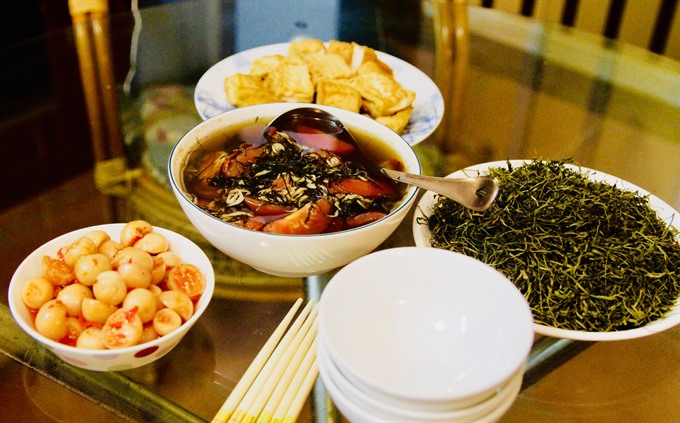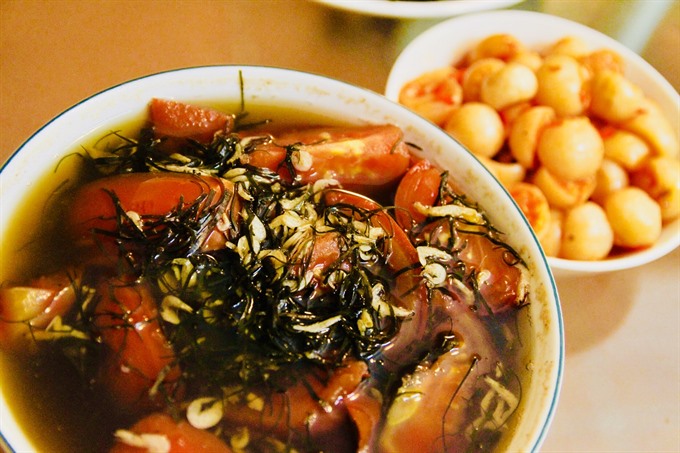Viet Nam News
By Ha Nguyen
Anyone who has enjoyed canh la lang, a unique dish of Nghe An people, particularly locals in Quynh Luu District, is struck by its bitter, acrid taste at first bite, before a sweet flavour hits your throat.
Located in the central region, Nghe An Province is bless beautiful landscapes, immense sea beaches, hills, mountains and meandering rivers.
Thanked to this diverse terrain, the province has abundant produce, including the famous la lang (locally known as Vietnamese ginseng, a kind of medicinal herb).
The lang tree is about 3-4 m high and grows on mountain slopes near creeks and along streams. Its serrated leaves are deep blue and its veins are dark red.
From the fourth to the seventh lunar months, the tree produces its tastiest leaves. During this time local people collect the leaves and dry them for use for the rest of the year, said 60-year-old local Nguyen Thi Nguyet.
“Housewives cook the leaves with pig’s insides, or use it to wrap grilled bream fish and dip it with chili-garlic fish sauce. But much more popular is that they cook lang soup with tiny shrimps and tomatoes,” she said.
 |
| Fit for a king: A tray including lang soup, a plate of dried lang leaves and a bowl of ca phao. |
She recalled that the dish had been handed down from her ancestors, some hundreds of years ago.
“At that time most villagers were very poor, they had no money to buy food, so they often cooked the leaves with tomatoes as soup to eat with rice.”
Nguyet said the soup is tastiest when eaten it with white rice, ca phao muoi (salted eggplants) and braised sea fish like bream. The light bitterness mixed with the sour flavor of salted ca phao and salty fish helps create a very tasty dish.
“While enjoying the soup, the dinner is if all aromatic flavours of forests, mountains and sea were mixed together and that flavour remains on your tongue for long,” she said.
The soup is a popular dish for Vietnamese inside and outside the country.
Overseas Vietnamese Pham Hong Bang in Ukraine’s Kiev, who comes from Quynh Luu District, said la lang soup is well-known across the world.
“At any location in the globe with Nghe (shorten name of Nghe An) people, that location has la lang.”
“Although we live in Kiev, my family is still a centre of the leaves that we receive from our village in Nghe An and then deliver to friends in Europe, America and Africa. An overseas Vietnamese in any place who receives a dried package of la lang often gives a bit to each of family his community to enjoy it and also to reduce their homesickness too,” Bang said.
 |
| Salty treat: A tasty and delicious lang soup to be eaten with ca phao (salted eggplants). |
He said though his family has settled in Kiev for more than 30 years, he has had to go without the soup.
“Thanked to lang soup, I still feel closely connected to my native Quynh Doi Village (of Quynh Luu District) where I was born and have enjoyed the soup through my life,” said Bang’s mother.
Bang said apart from cooking soup, the leaf is still used as medical properties to deal with summer heat, stimulating good digestion.
“We all consider the leaf our Vietnamese specialty,” he said.
Nghe An herbalist Ho Van Huan told Viet Nam News that lang trees are being widely planted in local gardens.
People in Quynh Luu’s Quynh Doi Village use 100g of lang leaves, which are already cut into threads, to boil with a litre of water to drink it year round.
“It helps to cool down heat from inside the body so most people here are healthy compared with people in other places,” Huan said, adding that locals in the district’s Quynh Thang Village use the leaf as a medicine to deal with itching, heat, broken bones and burns.
The leaves, which have featured in poems, song and the memories of Nghe people living far from home, are a key part of local life and need to be preserved. — VNS